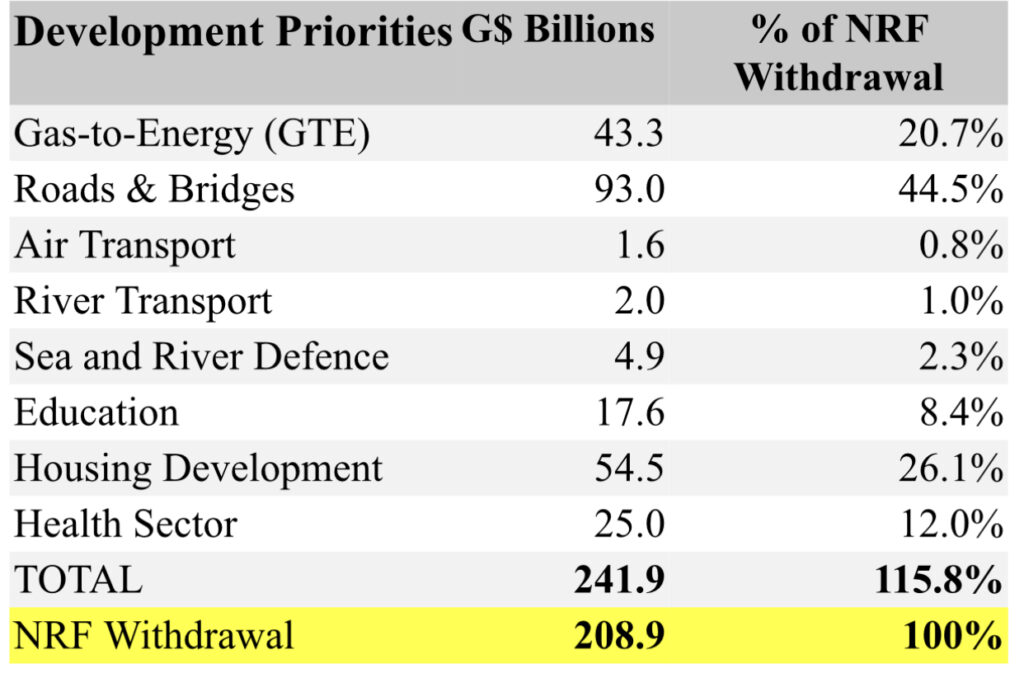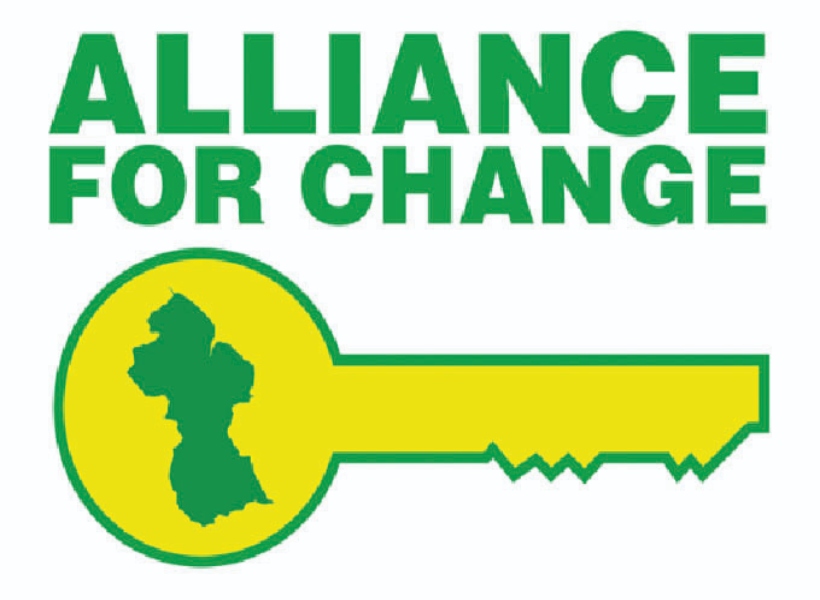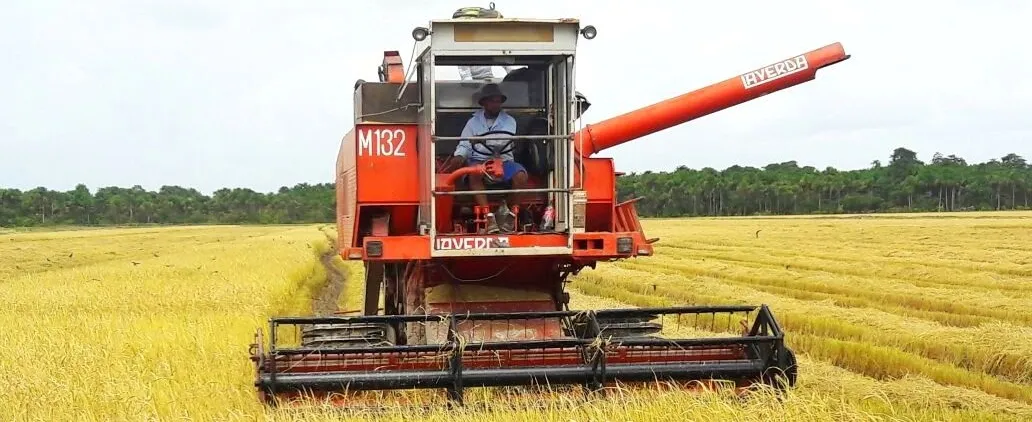Summary
Pursuant to the Natural Resource Fund (NRF) Act, all withdrawals from the NRF to finance the National Budget are subject to approval by the National Assembly. Once the budget is approved, only then the withdrawal can be effected, and this is done, not all at once, but throughout the fiscal year in various sums. Additionally, all withdrawals from the NRF shall be deposited into the Consolidated Fund in accordance with the NRF Act.
The national development priorities of the country are not State secret. Broadly speaking, the development priorities are: the energy sector aimed at reducing energy cost and delivering reliable supply of energy, infrastructure development, housing, education, health, and the green economy within the framework of the Low Carbon Development Strategy, just to name a few and for context.
With this in mind, it can be easily deduced from the national budget speech and estimates, the projects, and other areas in line with the national development priorities, that the NRF withdrawal will be used to finance
Introduction
The question of specificity regarding the expenditure of the withdrawals from the Natural Resource Fund (NRF) has surfaced in certain sections of the media. Additionally, concerns with regard to the investment mandate of the fund has also emerged.
Discussions surrounding these aspects of the NRF have been gaining critical attention, and they are not unreasonable questions to ask. This article, therefore, seeks to contribute to the discussion by attempting to provide answers to these questions.
Discussion and Analysis
Withdrawal from the Fund
Pursuant to the NRF Act, all withdrawals from the NRF to finance the National Budget are subject to approval by the National Assembly.
Once the budget is approved, only then the withdrawal can be effected, and this is done, not all at once, but throughout the fiscal year in various sums. Additionally, all withdrawals from the NRF shall be deposited into the Consolidated Fund (CF) in accordance with the NRF Act.
According to the withdrawal rules (first Schedule), the ceiling on annual withdrawals are as follows:
1. 100% of the first US$500 million
2. 75% of the second US$500 million
3. 50% of the third US$500 million
4. 25% of the fourth US$500 million
5. 5% of the fifth US$500 million
6. 3% of any amounts in excess of US$2.5 billion.
With this simplified formula, one can observe that the withdrawal rule of the fund is not calibrated to withdraw all of the monies from the NRF especially as the balance in the fund starts to grow.
The upfront drawdown from the fund is necessary to accelerate Guyana’s massive development agenda in infrastructure (new roads and bridges, social infrastructure, health care, education, national security, and ICT etc.), all aimed to modernize and transform the economy and diversify the economy.
Budget 2023 Sources of Funding
As illustrated in the chart attached, the 2023 national budget is financed from various sources as stated hereunder:
(1) Tax revenue accounting for 41% or $321.1 billion,
(2) Non-tax revenue accounting for 2% or $15.2 billion,
(3) Carbon credit inflow accounting for 4% or $31.28 billion,
(4) NRF withdrawal accounting for 27% or $208.9 billion, and
(5) Debt financing accounting for 26% or $206.5 billion.
The NRF Act establishes that the withdrawals from the NRF shall be used to finance the following:
a) National development priorities including any initiative aimed at realizing an inclusive green economy; and
b) Essential projects that are directly related to ameliorating the effect of a major natural disaster.
The national development priorities of the country are not State secret.
Broadly speaking, the development priorities are: the energy sector aimed at reducing energy cost and delivering reliable supply of energy, infrastructure development, housing, education, health and the green economy within the framework of the Low Carbon Development Strategy (LCDS), just to name a few and for context.
With this in mind, it can be easily deduced from the national budget speech and estimates, the projects, and other areas in line with the national development priorities, that the NRF withdrawal will be used to finance. This is demonstrated in the table attached.
As established previously, the NRF withdrawal represents 27% of the total budget (2023), amounting to $208.9 billion. The selected projects in the above table amounted to $241.9 billion, or 115.8% of the NRF withdrawal.
The Gas-to-energy project, which is a major national development priority, the sum of $43.3 billion is budgeted for same, representing 20.7% of the NRF withdrawal; the budgeted sum for roads and bridges represents 44.5% of the NRF withdrawal, the capital budget for education, housing and the health sector represents 8.4%, 26.1% and 12% respectively, of the NRF withdrawal.
Investment
Part V of the NRF Act, sections 22–27 establishes the eligible investment, the minimum investment in very safe investments, investment for long-term savings, passive investment management, and the investment mandate of the fund. Investment of fund applies to the balance net of withdrawals to finance the national budget. To this end, the Bank of Guyana which is vested with the operational management authority for the NRF, publishes monthly, quarterly, and annual reports.
Concluding Remarks
The national development priorities of the country are clearly outlined by the Government, in its manifesto, the LCDS, budget presentations, policy positions, and demonstrated through the types of policies being pursued within the broad framework of its development agenda. The withdrawals from the NRF can be clearly aligned with these priority areas identified in the national budget.
About the author
Joel Bhagwandin, MSc., is the Director of Financial Advisory, Market Intelligence, and Analytics at SphereX Professional Services Inc. He can be reached at [email protected].









